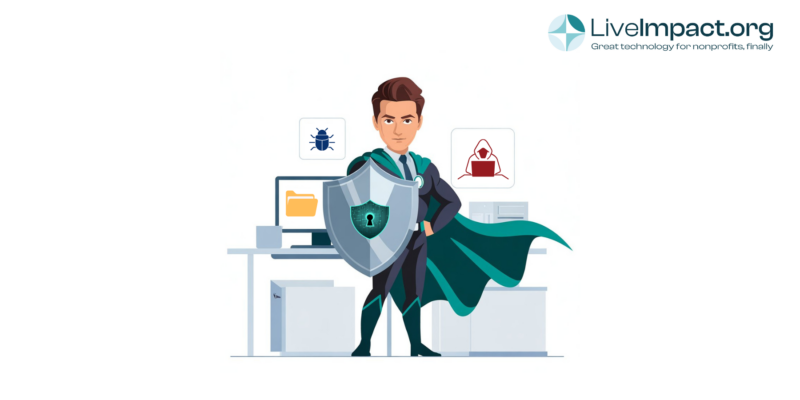In my five years of working in nonprofit database management, I’ve experienced my fair share of data disasters. Anyone in the nonprofit world has probably been there at least once: missing key information with an annual report looming, having to cross-check data across 13 separate systems and spreadsheets, and even higher-ups getting called in to help solve problems. It’s safe to say that this is not an experience I want to go through again.
In the best-case scenario, this is a significant, avoidable time drain on staff who are already stretched thin. In the worst case, it puts organizations at risk of losing funding, failing audits, and damaging their reputation. What’s interesting is that, in my experience, these situations aren’t usually anyone’s fault in particular. They’re a direct consequence of the systems (or lack of systems) in place to collect, manage, and use data.
So, there’s an obvious follow-up question: what systems should we implement to avoid these disasters before they become a problem? Below are a few strategies that can help your nonprofit become bulletproof.
One Single Source of Truth
The first step in avoiding data disasters is making sure that your information isn’t being stored in multiple, segmented locations. You might have heard of the term “data silos.” We want to avoid these at all costs. When systems don’t communicate with each other, it’s easy to end up with inconsistent information and uncertainty about what data you can trust.
As an example, I’ve seen case management programs where client data was tracked in different software depending on the grant. Because the systems were segmented, staff would enter some information in one place and some in another. Inevitably, when reporting time came, multiple days would be spent reconciling differences between systems. Reporting staff would have to figure out which version of the data was accurate before they could write any reports.
The solution is to have a system that serves as your single source of truth. This means using one platform where data is always correct and up to date. The easiest way to implement this is by using software that includes all the core functions your nonprofit needs. There are platforms that cover everything from case management to fundraising, volunteer management, and events. These all-in-one systems save time and money by eliminating the need to sync data manually between separate tools. Data is automatically updated across functions and programs, reducing the chance for error.
Carefully Consider Access Management and Visibility
Your staff never intends to make mistakes, but they happen. Errors during data entry, daily updates, or reporting can lead to big problems. When your funding and compliance rely on data accuracy, it’s important to take precautions.
One of the best ways to prevent mistakes is by controlling who can view and edit specific types of data. Giving everyone broad access is risky. The more people who have access, the more chances there are for accidental changes or deletions. With thoughtful access management, each staff member sees only the clients, programs, and funding relevant to their role. This minimizes the risk of unintended errors while still allowing staff to do their jobs effectively.
When selecting a system, make sure it offers robust access controls. The more precise you can get with permissions, the better. Ideally, you should be able to limit visibility not just by program, but even down to individual forms or fields within a client profile.
Be a Detective
Even with safeguards in place, mistakes can still happen. When they do, you need a way to investigate what went wrong. Did someone accidentally delete a record? Did something get overwritten? These issues are manageable if your system lets you go back and see what changed and when. Without that capability, you could be left trying to reconstruct key data from memory alone. Audit trails and activity logs can be lifesavers when you’re trying to fix a problem or explain an issue to a funder or supervisor.
A strong audit log should track changes at a granular level. This includes who made the change, what they changed, and when it happened. Ideally, it should also allow you to restore or reference previous versions of data. This doesn’t just help in a crisis. It also builds trust and transparency. When funders or board members ask how your data is being managed, you can confidently show that you have the tools in place to maintain accuracy and accountability.
This sort of detective work can also help identify broader patterns. If you notice recurring issues or frequent corrections in a certain area, it may be a sign that additional training is needed or that a process should be improved. In this way, tracking data changes becomes more than a safety net. It turns into a proactive strategy for improving operations, reducing risk, and strengthening your overall data quality.
Final Thoughts
Data disasters are stressful, time-consuming, and potentially very damaging to your organization, but they’re also avoidable. By centralizing your data, controlling access, and using systems with strong audit trails, you can protect your organization and your team. It’s not about assigning blame. It’s about putting the right tools in place so that you never have to scramble again. Make your nonprofit bulletproof, and transform your data infrastructure from a liability into a strength. LiveImpact’s case management, fundraising and volunteer management tools include all the features you need to stay bulletproof by default, with no extra stress on your end.


